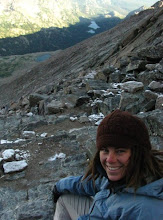[Setting: At a small guest house in Phonsavan, Laos. Evening. A guy on a bike just rode up, and jumps off of it likes he's spent some time on one before. Sweating, after a long day for riding around, he takes a drink of water, and wipes the perspiration from his brow. His name is Fabien. He is from France.]
ME: [thinking I may have found a "victim" to cycle to Cambodia with...] Hey! Where you going tomorrow?
FABIEN: South.
ME: Me too.
FABIEN: Where you going?
ME: Well, I'm going to Vientiane tonight on the night bus. But, I'm hoping to buy a bike and cycle to Cambodia from there. [throwing the idea out there...]
FABIEN: Really?? How long do you think it'll take?
ME: I'm not sure. Maybe a week?
FABIEN: Huh...
[one hour later, when I walk past him eating dinner and drinking a beer in a small cafe)FABIEN: You know about the bike?
ME: Yah? [thinking - yes! -maybe he wants to go...he seems like the type...adventures are more fun with a friend...]
FABIEN: I think I'd like to go. Yah yah yah.
ME: Sweet! Really? Ha! Well, here's my email address. Email me and we'll find bikes in Vientiane tomorrow...
That's how cycling over 700km through rural Laos started.
I'd had the idea for a few days before I met Fabien that I'd like to cycle through Southern Laos. After spending the previous 2 1/2 months trekking through mountains, I was getting tired of only riding buses in Thailand. It was time to move again...physically move...and cycling seemed like fun. So, why not? Meeting Fabien was an uncanny crossing of people in time and place; he turned out to be a great bike buddy.

In Vientiane, we found, bought, and outfitted cycles in one day. Running around the capital, trying to find a bike shop, then fixing brakes, bike seats, and finding some bike bags...it was beautiful chaos. The next morning, we set out.
We met lots of fun(ny) people and saw interesting places along the way. Memorable moments...
-sleeping in a monastery, and parking the bikes in front of Buddha. Oops. A monk came over and told us to move them. Lesson #1: No bikes in front of Buddha.
-Fabien accidentally ordering things he didn't really want...like the time he thought he was getting a hard boiled egg...and the "egg" came but with a partially developed baby bird inside, hair included.
-taking shoes off to enter a guesthouse, but after kicking off the shoes, rolling the bicycles into the room
-riding into Pakse and the bank sign showing 40 degrees centigrade...over 100 degrees F
-on being saddle sore, to quote Fabien: "you know, everything is great. really just great. except, i don't know what to do about this pain in my ass."
-trying to take a short cut after seeing the temples of Champasak, and instead ending up on a gravel road in the middle of nowhere. bone-jarring riding, constant dust in the face from passing vehicles, scorching sun. worrying if we could find a way back across the Mekong...we were in luck. managed to score a boat taxi to the others side, and then after 3km of riding single-track over roots and potholes (remember we are on fully-loaded road bikes), popping out onto Route 13 going, Where in the world are we? The good news: We were 8km farther south than we thought we'd

be, but 8km in the correct direction.
-the feeling of relief and accomplishment on reaching the 4,000 Islands of the Mekong at sunset, just kilometers from the Cambodian border, after a hard week of riding.
Once we got to the 4,000 Islands we managed to sell the bikes to couple that owned a guesthouse on Don Khon. However, it was only once we reach the islands that Fabien realized: a) he was out of money and b) the closest ATM was 3 hrs. in the opposite direction. We decided that the only thing to do - other than putting Fabien on a bus immediately to Pakse - was to sell the bikes right then. Our clients ended up being an older French speaking Laos couple. First they only wanted my bike, but then decided they wanted Fabien's, too. That they spoke French, and that Fabien was from France...well, it was very convenient for the business transaction. :) We bought the bikes for $80, sold them for $50. They got a good price, and I definitely felt I had my $30 of fun out of the deal.
And that is how cycling 700km through rural Laos ended. Lots of fun, fried rice, fried eggs, sticky rice, and Laos coffee. I'm glad it worked out...it started with an idea...and ended on an island in the middle of the Mekong River, bikeless, tired, but all the better from the ride and all the laughter. The next day, Fabien headed to Bangkok to meet some friends, and I took a bus south to Cambodia and Angkor Wat.
http://picasaweb.google.com/andriadhautamaki/8DaysOnABicycleThroughLaos#












